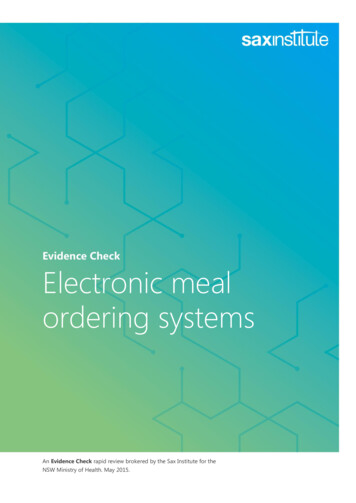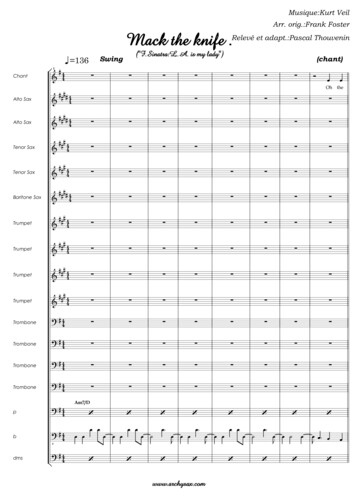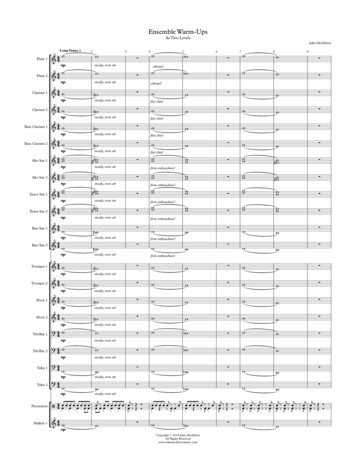
Transcription
Electronic mealordering systemsAn Evidence Check rapid review brokered by the Sax Institute for theNSW Ministry of Health. May 2015.
An Evidence Check rapid review brokered by the Sax Institute for the NSW Ministry of Health.May 2015.This report was prepared by:Mirela Prgomet, Ling Li, Julie Li, Andrew Georgiou, Johanna Westbrook.May 2016 Sax Institute 2016This work is copyright. It may be reproduced in whole or in part for study training purposes subject tothe inclusions of an acknowledgement of the source. It may not be reproduced for commercial usageor sale. Reproduction for purposes other than those indicated above requires written permission fromthe copyright owners.Enquiries regarding this report may be directed to the:HeadKnowledge Exchange ProgramSax @saxinstitute.org.auPhone: 61 2 91889500Suggested Citation:Prgomet M, Li L, Li J, Georgiou A, Westbrook J. Electronic meal ordering systems: an Evidence Check rapidreview brokered by the Sax Institute (www.saxinstitute.org.au) for the NSW Ministry of Health, 2015.Disclaimer:This Evidence Check Review was produced using the Evidence Check methodology in response tospecific questions from the commissioning agency.It is not necessarily a comprehensive review of all literature relating to the topic area. It was current atthe time of production (but not necessarily at the time of publication). It is reproduced for generalinformation and third parties rely upon it at their own risk.
Electronic meal orderingsystems: an Evidence Checkrapid reviewAn Evidence Check rapid review brokered by the Sax Institute for the NSW Ministry of Health.May 2015.This report was prepared by M Prgomet, L Li, J Li, A Georgiou, J Westbrook.
Contents1 CHSSR Overview. 5Mission . 5Aims . 52 Executive Summary . 63 Background . 84 Method . 104.1. Search methods . 10Table 1. Literature search strategy applied in Medline and Embase . 10Table 2. Breakdown of authors and content experts contacted . 11Table 3. List of sources hand-searched for peer-reviewed and grey literature . 114.2. Study Selection . 12Figure 1. Literature identification and selection process . 135 Overview of the Literature . 145.1.1. Types of Electonic Meal Ordering Systems and Reforms Reported in the Literature. 145.1.2. Nutritional Screening and Risk Assessment Protocols in Electronic Meal Ordering . 175.2. Evaluation of Electronic Meal Ordering Systems . 185.2.1. Nature and Quality of the Evidence . 185.2.2. Impact of Electronic Meal Ordering Systems . 186 Considerations for Further Research and Evaluation . 236.1. Challenges in Existing Evaluations of Electronic Meal Ordering Systems . 23Table 4. Evaluation Outcomes and Indicators used in Existing Studies . 246.2. Further Research Considerations . 267 Conclusion . 288 References . 299 Appendices . 32Appendix A: Database and grey literature search strategies . 32Appendix B: Summary of the literature on the impact of electronic meal ordering on hospital and patientoutcomes . 374 ELECTRONIC MEAL ORDERING SYSTEMS AN EVIDENCE CHECK RAPID REVIEW SAX INSTITUTE
1 CHSSR OverviewThe Centre for Health Systems and Safety Research (CHSSR) conducts innovativeresearch aimed at understanding and improving the way in which health caredelivery and patient outcomes are enhanced through the effective use and exchangeof information. It is one of three research centres that form the Australian Institute ofHealth Innovation (AIHI) at Macquarie University.MissionThe Centre’s mission is to lead in the design and execution of innovative health systems research focusedon patient safety and the evaluation of information and communication technologies in the health sector,to produce a world-class evidence base that informs policy and practice.AimsThe Centre’s research is underpinned by a systems perspective, which uses highly innovative and wideranging research methods. Its research team is characterised by its talent and enthusiasm for workingwithin and across discipline areas and sectors. The Centre has a focus on translational research, aimed atturning research evidence into policy and practice, while also making fundamental contributions tointernational knowledge.The Centre’s research program has four central aims: Produce research evidence of the impact of information and communication technologies (ICT) on theefficiency and effectiveness of health care delivery, on health professionals’ work and on patientoutcomes Develop and test rigorous and innovative tools and approaches for health informatics evaluation Design and apply innovative approaches to understand the complex nature of health care deliverysystems and make assessments of health care safety Disseminate evidence to inform policy, system design, practice change and the integration and safeand effective use of ICT in healthcare.
2 Executive SummaryIn 2014, HealthShare NSW commenced the development of a new delivery model for patient food services.A set of nutrition standards for menus and specifications for therapeutic diets was developed by theAgency for Clinical Innovation (ACI) to facilitate centralised menu planning and food production. Thesestandards form part of a broader framework to improve nutritional care in NSW hospitals, including reformto the current paper-based meal ordering system with implementation of electronic meal ordering. Theelectronic meal ordering system is expected to produce multiple benefits for organisations and patients.A request was made by the Workforce Planning and Development Branch, at the NSW Ministry of Health, toundertake a literature scan to identify and summarise current evidence regarding electronic meal orderingsystems in order to inform the planning and evaluation of the NSW meal ordering system reforms. Thisreport presents findings from an evidence scan of literature, from Australia and internationally, onelectronic meal ordering system reforms and their associated impacts on hospital and patient outcomes.The period of the review spanned 15 years, from January 2000 to December 2015.The objectives addressed by the review were to: Describe the types of electronic meal ordering systems and food service reforms related to theintroduction of electronic meal ordering systems that have been reported in the literature Describe any nutritional screening and risk assessment protocols implemented alongside electronicmeal ordering systems Present evidence of the impact of electronic meal ordering systems on patient outcomes and onimplications for staff, and Discuss considerations for future evaluations of electronic meal ordering systems based on theevidence identified in the literature.Identified literature describing meal ordering and associated food service reforms discussed threecategories of electronic meal ordering: (i) the “spoken menu” model; (ii) the “room service” model; and (iii)the “self-service” model. The spoken menu model involves a staff member attending the patient bedside,discussing food options with the patient, assisting the patient with meal selection based on their dietaryrequirements, and electronically entering the patient’s meal order onto a mobile computing device at thepatient bedside. In the room service models, patients place their meal orders by calling a dedicated numberwhere staff take the meal orders and enter them directly into a computer, while the self-service modelinvolves patients’ entering their orders directly via bedside terminals. Prior to transitioning to an electronicmeal ordering system, most hospitals had a traditional “printed menu” model.Most of the literature discussing electronic meal ordering provided information on some level of evaluationof the impact of system implementation. Patient satisfaction outcomes were most frequently reported. Onlya few studies examined the effectiveness of electronic meal ordering systems in reducing meal errors or theimpact on patient nutritional intake. Cost savings, rates of food waste, and impact of the meal orderingprocess on staff were also evaluated in the literature, but the extent and quality of evidence on theseindicators was limited. Overall, the available evidence indicated that electronic meal ordering systems mayimprove patient satisfaction, increase nutritional intake and decrease food waste.Hospital food service reforms are complex, involving adjustments to the menu, ordering process,production, meal delivery and staffing. Future evaluations of electronic meal ordering should address the6 ELECTRONIC MEAL ORDERING SYSTEMS AN EVIDENCE CHECK RAPID REVIEW SAX INSTITUTE
organisational goals for implementation of a system-supported food service model, with methods formeasuring defined indicators using robust measurement tools. Considerations and challenges for futureevaluation studies are presented in this report.ELECTRONIC MEAL ORDERING SYSTEMS AN EVIDENCE CHECK RAPID REVIEW SAX INSTITUTE 7
3 BackgroundMalnutrition in hospital patients is a serious clinical issue associated with prolonged hospital stay, frequentreadmissions, increased hospital infection, morbidity and mortality.1-3 It is therefore important for hospitalsto implement interventions that will support the provision of optimal nutritional management and care forpatients. Health information technologies, such as electronic medical records, computerised provider orderentry systems, laboratory information systems and medication management systems, have played anintegral role in improving healthcare delivery, patient safety and clinical decision-making.4 Nutritioninformation systems, such as dietary management systems, offer a valuable opportunity to enhance theefficiency of food services and support nutritional care.5 Beyond supporting functions such as inventory andmenu management, dietary management systems hold the potential for managing, delivering, andmonitoring food, nutrient, and fluid intake on an individual patient basis and better identifying patients atrisk of malnutrition.5, 6A variety of clinical and behavioural factors may influence dietary intake.2, 3 Poor nutritional consumptionmay also be influenced by food service systems characterised by a poorly designed menu, inappropriatefood preparation methods and complex ordering processes.7 A review of food service systems wherepatients select meals closer to the time of consumption, such as the bulk trolley system, found that a morepersonalised meal service system can lead to improved patient satisfaction and energy intake.8 However, acomparative analysis of plated versus bulk trolley systems found bulk systems to result in higher food wastewith no beneficial effect on patient nutrition compared to plated systems.9 Food service systems thatincorporate electronic meal ordering offer an alternative to traditional models of patient meal servicesystems and combine a personalised meal service experience with the potential nutritional managementbenefits of dietary management systems.In 2014, HealthShare NSW commenced the development of a new delivery model for patient food services.A set of nutrition standards for menus and specifications for therapeutic diets was developed by theAgency for Clinical Innovation (ACI) to facilitate centralised menu planning and food production.10-12 Thesestandards form part of a broader framework to improve nutritional care in NSW hospitals13, includingreform to the current paper-based meal ordering system with implementation of electronic meal ordering.Notional modelling by Deloitte14, 15of the impact associated with implementation of an electronic mealordering system has suggested: process saving costs (i.e. by reducing the need to print, distribute, collectand process paper-based menus); reduced food wastage; reduced patient length of stay; and increasedpatient satisfaction through greater choice and more timely meal ordering and food delivery. However, it iscurrently unknown whether the anecdotally reported benefits of electronic meal ordering systems havebeen evaluated within the literature.This report aims to identify and present a review of the existing evidence, from Australia and internationally,on electronic meal ordering system reforms and their associated impacts on hospital and patient outcomes.The main objectives of this report are to: Describe the types of electronic meal ordering systems and food service reforms related to theintroduction of electronic meal ordering systems that have been reported in the literature Describe any nutritional screening and risk assessment protocols implemented alongside electronicmeal ordering systems8 ELECTRONIC MEAL ORDERING SYSTEMS AN EVIDENCE CHECK RAPID REVIEW SAX INSTITUTE
Present evidence of the impact of electronic meal ordering systems on patient outcomes and on theimplications for staff, and Discuss considerations for future evaluations of electronic meal ordering systems based on theevidence identified in the literature.ELECTRONIC MEAL ORDERING SYSTEMS AN EVIDENCE CHECK RAPID REVIEW SAX INSTITUTE 9
4 MethodWe sought to identify literature on reforms to meal ordering systems in healthcare facilities in developedcountries where there has been an introduction of an electronic meal ordering system. The search focusedon English-language literature published since the year 2000. We included peer-reviewed literature, as wellas research reported in grey literature (e.g. reports by government departments and public or private healthservice providers).4.1. Search methodsWe undertook an initial general search for “electronic meal ordering” in the Google search engine. Titlesand the short descriptive text underneath were screened for the first 10 pages of results (representing 100individual results). Potentially relevant records were opened and reviewed. Relevant articles and documentswere retrieved, while related sources were electronically bookmarked for subsequent follow-up. Tosupplement the Google search, searches within the top 10 journals in the nutrition and dietetics category,as ranked by the Web of Science citation index, were also conducted.Keywords and their synonymous variations that appeared across the relevant results retrieved from theinitial Google search were identified and noted. Complete reference details of scholarly articles identifiedfrom the Google search were also retrieved for identification of the specialised indexing terms (e.g. MeSH,Emtree terms) under which they were classified. An initial database search strategy was then formed using acombination of indexing terms and keywords. Indexing terms varied across databases, thus terms weremapped to their equivalents for use in the different databases. Search strategies were trialled andcontinually modified until relevant results from the initial hand-searching were also identified by the formalsearch strategy. The final search strategy used in Medline and Embase is presented in Table 1. The searchstrategies used for the remaining databases (CINAHL, Evidence-Based Medicine (EBM) Reviews, ProQuest,ScienceDirect, Web of Science, Scopus, Global Health, Joanna Briggs Institute of Evidence Based Practice,and Food Science and Technology Abstracts) are presented in Appendix A.Reference lists of all literature identified as potentially relevant were reviewed. Article authors andindividuals in hospitals where electronic meal ordering systems had been implemented were emailed arequest for further available details and/or evidence from internal trials. A breakdown of the number ofauthors contacted and responses received is presented in Table 2. The complete list of sources that werehand-searched for additional peer-reviewed literature, as well as grey literature is summarised in Table 3.Table 1. Literature search strategy applied in Medline and EmbaseMedline and Embase Search Strategy1exp Meals/2meal#.ab,ti.3food.ab.ti.41 or 2 or 35Food Preferences/ or Food Service, Hospital/ or Food Services/ or Food Handling/6Dietary Services/10 ELECTRONIC MEAL ORDERING SYSTEMS AN EVIDENCE CHECK RAPID REVIEW SAX INSTITUTE
7Nutrition Assessment/8Dietetics/9Menu Planning/10food delivery.ab.ti.11food service#.ab,ti.12foodservice.ab,ti.135 or 6 or 7 or 8 or 9 or 10 or 11 or 1214Information Systems/ or Health Information Systems/ or Hospital Information Systems/15information 14 or 15 or 16 or 17 or 18 or 19 or 20224 and 13 and 2123limit 22 to English language and publication year 2000n to current/ denotes an indexed term.ab.ti. abstract and titleTable 2. Breakdown of authors and content experts contactedCategory of ExpertNumber ContactedCountriesNumber RespondedHospital apore1*includes staff from foodservices, nutrition and dietetics, or information technology departmentTable 3. List of sources hand-searched for peer-reviewed and grey literatureGrey Literature/Hand-searchingGoogle and Google ScholarNational Health Service (NHS) United KingdomAgency for Clinical Innovation (ACI)ProQuest Dissertations and Theses DatabaseTop 10 Nutrition and Dietetics journals as ranked by Web of Science citation indexELECTRONIC MEAL ORDERING SYSTEMS AN EVIDENCE CHECK RAPID REVIEW SAX INSTITUTE 11
Canadian Foundation of Dietetic Research website and conference proceedingsSouth West Pacific Nutrition and Dietetic Conference proceedingsProceedings of the Nutrition Society of AustraliaArticle reference listsAuthors/content experts – emailed request for information4.2. Study SelectionBoth the titles and abstracts of all unique citations from the database search were reviewed for relevance.Where an abstract was not available, the full-text of the article was retrieved for review. For the purposes ofthis review, electronic meal ordering was defined as any meal ordering process where patient food ordersare entered directly into a computer (by either a staff member or the patient) and transmitted electronicallyto the kitchen.All study types and sources reporting non-testimonial evidence relating to outcomes or descriptions ofelectronic meal ordering system implementations from both the database search and hand-searching wereincluded in the review. Sources were excluded if they were: unrelated to the topic; featured electronic mealordering outside the health context (e.g. restaurants, private residences); were set in developing countries;or had non-electronic food service models. While the search was not confined to hospital settings, we didnot identify any literature that discussed electronic meal ordering systems in non-hospital health caresettings. Ambiguous references were independently examined by two researchers and disagreements wereresolved through discussion. The study selection process is diagrammatically represented in Figure 1.12 ELECTRONIC MEAL ORDERING SYSTEMS AN EVIDENCE CHECK RAPID REVIEW SAX INSTITUTE
Figure 1. Literature identification and selection processMEDLINEEmbaseCINAHLn 126n 272n 572EBMReviewsn 123FoodProQuestn 336ScienceDirectWeb ofSciencen 9n 14ScopusGlobal HealthJoanna BriggsTechnologyn 107n 3n 25n 3Total citations identified from databasesn 1590Duplicates excludedn 281Title and abstract screenn 1309Excluded citationsn 1238Full text reviewn 71Additional citations identified(including grey literature)n 24Content expertsn 113 ELECTRONIC MEAL ORDERING SYSTEMS AN EVIDENCE CHECK RAPID REVIEW SAX INSTITUTEExcluded references, n 65Not relevant studyManual meal ordering processDeveloping countryIncluded sourcesn 31Science &
5 Overview of the LiteratureLiterature describing electronic meal ordering systems and associated food service reforms was notextensive. In total, we identified 31 relevant sources of information comprising peer-reviewed publications,conference abstracts/posters, hospital newsletters and content expert presentations. Some individualsources pertained to the same hospitals and electronic meal ordering systems. In such cases, we pooled themultiple sources of information about the system to build a more complete picture regarding the system.Thus, overall the sources discussed electronic meal ordering in 22 hospitals.5.1. Description of Electronic Meal Ordering Systems and Reforms5.1.1. Types of Electonic Meal Ordering Systems and Reforms Reported in the LiteratureWithin the evidence base we identified three categories of food service models that incorporate electronicmeal ordering systems: (i) the “spoken menu” model; (ii) the “room service” model; and (iii) the “self-service”model. Prior to transitioning to an electronic meal ordering system, most hospitals had a traditional“printed menu” model: where staff delivered printed paper meal ordering forms to patients’ rooms, patientscompleted the forms to indicate their meal preferences and staff returned to collect the forms at a laterpoint in time. Under the printed menu system, patients have limited interaction with meal ordering staff 16and commonly do not receive their selected meals until their third day of stay in hospital.17, 18 Additionally,orders are associated with the bed rather than the patient, thus if a patient is transferred or discharged, thenewcomer to that bed receives the meal ordered by the previous patient.19 In one study, however, prior toelectronic meal ordering system implementation staff took patients’ orders at the bedside but documentedthe orders on paper.20 In another study, patients’ meals were selected for them by a software system basedon the patients’ diet orders and food allergies.21Spoken MenuOf the three models, we identified the greatest number of sources describing spoken menu models. Thespoken menu model involves a staff member attending the patient bedside, discussing food options withthe patient, assisting them with meal selection based on their dietary requirements and taking the patient’smeal order. The order can be documented on paper or entered onto a mobile device (e.g. personal digitalassistant/smartphone, tablet computer or computer on wheels). For the purposes of this review, we onlyincluded literature that explicitly specified the use of mobile devices for meal ordering. Studies on spokenmenu models that used paper, or were ambiguous about the means by which orders were taken22-24, wereexcluded from this review.17, 20, 21, 25-30 The reasons reported for changing to a spoken menu system included:to provide support to patients at meal times25; allow patients to choose meals closer to meal times17, 20, 21;improve order appropriateness20 and accuracy20; increase food consumption25; improve nutrition25; reducefood cost21 and waste21, 28; improve efficiency28; and improve patient21, 31 and staff satisfaction with foodservices.31 However, there is only limited evidence evaluating whether these benefits are actually attainedfollowing spoken menu implementation (see Section 3.2).A summary of the spoken menu systems reported in the literature is presented in Box 1. There weredifferences in how the spoken menu system operated in the different hospitals with regards to when andhow frequently meal orders are taken. In some hospitals, meal orders are taken the day prior to mealdelivery25, 32, while in other hospitals orders are taken as close to the next meal time as possible (e.g. withintwo hours of meal delivery).17, 20, 21, 25, 33, 34 Across most studies, responsibility for taking meal orders was14 ELECTRONIC MEAL ORDERING SYSTEMS AN EVIDENCE CHECK RAPID REVIEW SAX INSTITUTE
largely assigned to the food services staff (e.g. catering associates, catering staff, customer serviceassociates).21, 25, 31 However, in two studies conducted in Australian hospitals27, 30 and one study in aCanadian hospital17, staff from nutrition and dietetics (trained nutrition or dietary assistants) wereresponsible for taking meal orders.Box 1. Summary of spoken menu reforms reported in the literaturePrince Charles Hospital, Queensland, Australia 28, 29 – CBORD implemented in 2006. Orders are taken atthe bedside by food service staff. Automatic generation of meal order tickets.North York General Hospital (NYGH) and Humber River Regional Hospital (HRRH), Toronto,Canada25 – Steamplicity food service system implemented in 2009. Reform included changes to themenu, ordering procedures and cooking process. Orders are taken at the bedside by catering associatesseveral times a day.Hollywood Private Hospital, Perth, Western Australia 26, 31, 32 – Chefmax implemented in 2011. Multifaceted program of change to transform the entire meal production, ordering and delivery process.Included new menus reviewed by dietetics, electronic meal ordering, kitchen process improvement andstaff training. Orders are taken by catering staff for meals that will be delivered the following day.Sturgeon Community Hospital, Alberta, Canada33 – trialled spoken menu in 2004. Orders were takentwice daily, with food service staff taking orders as close to the next meal time as possible.Wollongong Hospital, Port Kembla Hospital, Shellharbour Hospital, Bulli Hospital and ShoalhavenHospital, New South Wales, Australia30 – implemented CBORD. The hospitals moved to a centralisedcook-chill production alongside implementation of electronic meal ordering. Orders are taken bynutrition assistants and uploaded into CBORD.Trillium Health Centre, Toronto, Canada21, 34, 35 – under the old system, patients’ meals were selectedfor them by a software system based on the patients’ diet orders and food allergies. ImplementedMeditech food service software. Only reform was to meal ordering process (no changes to menu,method of preparation, or delivery). Lunch and dinner orders are taken by a customer service associate(food services staff member) once a day.St Michael’s Hospital, Toronto, Canada17 – implemented CBORD. Orders taken by dietary assistants ona daily basis and wirelessly uploaded into the CBORD food management system.St Vincent’s Private Hospital, Sydney, Australia 27, 36-38 – under the old system, nutrition assistantsdelivered and collected printed paper menus and then entered the orders onto the computer.Implemented CBORD. The menu and food items offered did not change. Orders are taken by nutritionassistants for dinner the same day, and breakfast and lunch for the following day.KK Women’s and Children’s Hospital, Singapore20 – under the old
systems in order to inform the planning and evaluation of the NSW meal ordering system reforms. This report presents findings from an evidence scan of literature, from Australia and internationally, on electronic meal ordering system reforms and their associated impacts on hospital and patient outcomes.










